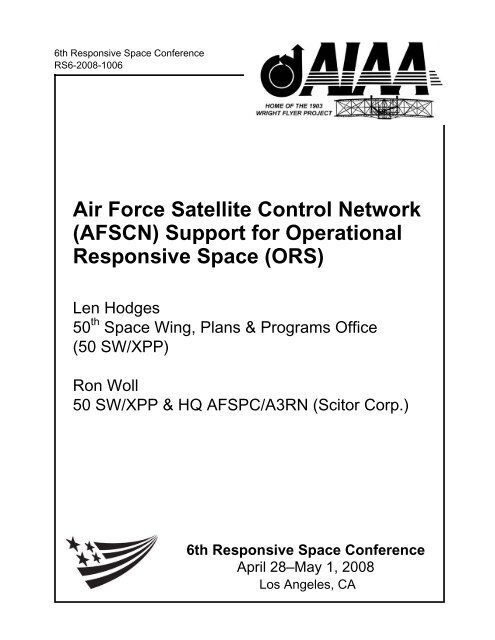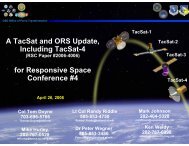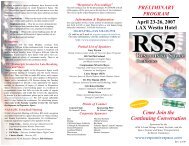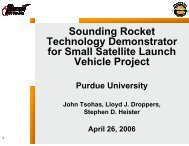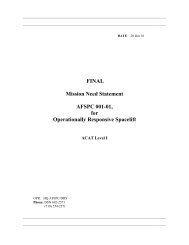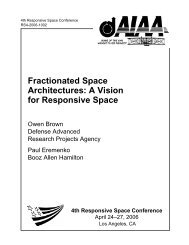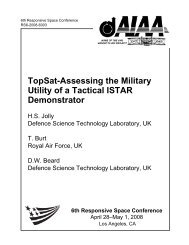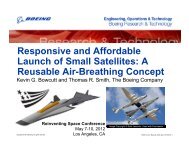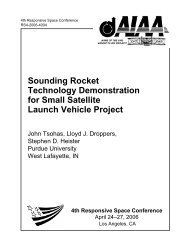Air Force Satellite Control Network (AFSCN) - Responsive Space
Air Force Satellite Control Network (AFSCN) - Responsive Space
Air Force Satellite Control Network (AFSCN) - Responsive Space
Create successful ePaper yourself
Turn your PDF publications into a flip-book with our unique Google optimized e-Paper software.
6th <strong>Responsive</strong> <strong>Space</strong> Conference<br />
RS6-2008-1006<br />
<strong>Air</strong> <strong>Force</strong> <strong>Satellite</strong> <strong>Control</strong> <strong>Network</strong><br />
(<strong>AFSCN</strong>) Support for Operational<br />
<strong>Responsive</strong> <strong>Space</strong> (ORS)<br />
Len Hodges<br />
50 th <strong>Space</strong> Wing, Plans & Programs Office<br />
(50 SW/XPP)<br />
Ron Woll<br />
50 SW/XPP & HQ AFSPC/A3RN (Scitor Corp.)<br />
6th <strong>Responsive</strong> <strong>Space</strong> Conference<br />
April 28–May 1, 2008<br />
Los Angeles, CA
AIAA-RS6-2008-1006<br />
<strong>Air</strong> <strong>Force</strong> <strong>Satellite</strong> <strong>Control</strong> <strong>Network</strong> (<strong>AFSCN</strong>)<br />
Support For<br />
Operational <strong>Responsive</strong> <strong>Space</strong> (ORS)<br />
Len Hodges<br />
<strong>AFSCN</strong> Program Support Manager (PSM)<br />
50th <strong>Space</strong> Wing, Plans & Programs Office (50 SW/XP)<br />
210 Falcon Parkway, Schriever AFB, CO 80912<br />
DAF Civilian, (719) 567-2967<br />
Len.Hodges@Schriever.Af.Mil<br />
Ron Woll<br />
50 SW/XPP & HQ AFSPC/A3RN<br />
<strong>AFSCN</strong> Systems Engineer<br />
Program Requirement Analysis<br />
Scitor Corp, (408) 489-2688<br />
Rwoll@Scitor.Com<br />
ABSTRACT<br />
The <strong>AFSCN</strong> is a common user, satellite control network that supports the Department of Defense (DoD), the<br />
Intelligence Community (IC), National Aeronautics and <strong>Space</strong> Administration (NASA) and National Oceanic and<br />
Atmospheric Administration (NOAA) programs. The <strong>AFSCN</strong> can provide a worldwide network communications<br />
infrastructure to ORS programs that should be considered as primary ground communications architecture for ORS<br />
planning and requirements. There is no charge for DoD or IC use of the <strong>AFSCN</strong>. Currently the <strong>AFSCN</strong> has eight<br />
remote ground facilities (RGFs) located around the world with a total of 15 antennas or remote tracking stations<br />
(RTS). Future plans are to expand to 10 RGFs with 19 RTSs. The tracking stations operate in the L-band for uplink<br />
and S-band downlink (e.g. <strong>Space</strong> Ground Link Subsystem [SGLS]). Future plans are to also include S-band for both<br />
up and down link communication (e.g. Unified S-Band [USB]). The <strong>AFSCN</strong> is composed of three segments: the<br />
Range Segment, consisting of 15 RTS, which provides the ground to spacecraft interface; the Communication<br />
Segment which connects the RTS to the two Operational <strong>Control</strong> Nodes (OCN); and the <strong>Network</strong> Management<br />
Segment which provides network scheduling and network status. The user must provide the command and control<br />
(C2) system (i.e. SOC), and have a scheduling and communications control interface to the <strong>AFSCN</strong>. The user must<br />
build a RTS configuration database (includes the uplink frequency, command rate, downlink frequency and signal<br />
format, etc.). As a common user network each user’s requirements are satisfied according to their mission priority.<br />
The user submits a schedule request to the <strong>AFSCN</strong> <strong>Network</strong> Operations Center (NOC) for arbitration. The <strong>AFSCN</strong><br />
can be used by ORS to provide ground system to space craft communications. This provides satellite Telemetry,<br />
Tracking and Commanding for the satellite bus and possibly the payload. NOTE: Although the ground system is<br />
many times the last piece of the puzzle in a satellite program, it is a necessity that cannot be placed at the end of the<br />
planning and funding cycle. Whether the <strong>AFSCN</strong> is used or not, the ORS ground system must be planned at the<br />
same time as the space craft and tested with the space craft before launch. (i.e. a critical lesson learned).<br />
This paper is declared a work of the U.S. Government<br />
and is not subject to copyright protection in the United<br />
States.<br />
<strong>AFSCN</strong><br />
1<br />
AIAA/6th <strong>Responsive</strong> <strong>Space</strong> Conference 2008<br />
The <strong>AFSCN</strong> is a common user, unclassified network<br />
where all users share the network within a disciplined
AIAA-RS6-2008-1006<br />
network schedule. The <strong>AFSCN</strong> is composed of three<br />
segments: range, communications and network<br />
management. Each segment will be addressed below. A<br />
complete definition for all segments is available in the<br />
System Interface Specification listed in the supporting<br />
documents of this paper.<br />
The <strong>AFSCN</strong> is a global network consisting of eight<br />
ground locations with 15 remote tracking stations<br />
operating in the (SGLS) frequency spectrum. The<br />
primarily northern hemisphere tracking stations provide<br />
support for Low Earth Orbit (LEO), Medium Earth<br />
Orbit (MEO), Highly Elliptical Orbit (HEO),<br />
Geosynchronous Earth Orbit (GEO) and L1 & L2 (i.e.<br />
first and second Sun-Earth Libration [or Lagrange]<br />
Point) orbits. In progress network upgrades will add a<br />
16th remote tracking station at Diego Garcia about FY-<br />
10. There is also an initiative to become interoperable<br />
with multiple space networks (e.g. GPS, NASA-<br />
NOAA) that could affectively increase the network to<br />
even more available tracking stations.<br />
<strong>AFSCN</strong> Resources<br />
OAFS<br />
Onizuka <strong>Control</strong> Node<br />
Onizuka <strong>Air</strong> <strong>Force</strong> Station<br />
Sunnyvale, CA<br />
NHS<br />
New Hampshire Station<br />
New Boston AFS, NH<br />
TTS<br />
Thule Tracking Station<br />
Thule AB, Greenland<br />
TCS<br />
Telemetry & Command<br />
Squadron<br />
Oakhanger, England<br />
VTS<br />
Vandenberg Tracking Station<br />
Vandenberg AFB, CA<br />
GTS<br />
Guam Tracking Station<br />
Andersen AFB, Guam<br />
HTS<br />
Hawaii Tracking Station<br />
Kaena Point, HI<br />
SAFB<br />
Schriever <strong>Control</strong> Node<br />
Schriever AFB, CO<br />
KEY TO SYMBOLS<br />
Operational <strong>Control</strong><br />
Node<br />
Remote Tracking<br />
Station (RTS)<br />
CTS<br />
Colorado Tracking Station<br />
Schriever AFB, CO<br />
TSTR<br />
Transportable <strong>Space</strong> Test<br />
Resource<br />
Kirtland, AFB, NM<br />
TVCF<br />
Transportable Vehicle<br />
Checkout Facility East<br />
Cape Canaveral AFS, FL<br />
DGS<br />
Diego Garcia Station<br />
Brit. Indian Ocean Terr.<br />
Diego Garcia Island<br />
Transportable ARTS<br />
Core<br />
Transportable<br />
Antenna<br />
Range Segment<br />
The range segment is the actual ground stations<br />
composed of the core electronic equipment and the<br />
antenna. The antennas are currently a mixture of several<br />
sizes ranging from 10 meters to large, high power 60<br />
foot diameter dish. The current upgrade will replace all<br />
antennas with a three axis, 13 meter antenna to provide<br />
2<br />
AIAA/6th <strong>Responsive</strong> <strong>Space</strong> Conference 2008<br />
network standardization. The <strong>AFSCN</strong> operational<br />
frequency spectrum is L band, 1760-1842 MHz, uplink<br />
and S band, 2200-2300 MHz, downlink. With the<br />
completion of the RTS Block Change (RBC) upgrade<br />
an S band, 2025-2110 MHz uplink will be included<br />
along with the current S band 2200-2300 MHz,<br />
downlink capabilities. The RTS electronics core allows<br />
multiple common data formats to support the user
AIAA-RS6-2008-1006<br />
needs. It is vital for early integration of the <strong>AFSCN</strong><br />
engineering personnel with the satellite program<br />
engineering personnel to define and coordinate the<br />
wave forms, and the power requirements and the<br />
network availability (i.e. loading analysis).<br />
Communication Segment<br />
The <strong>AFSCN</strong> communications architecture is Node<br />
centric. Node centric means all users access the <strong>AFSCN</strong><br />
by connecting to one of the two geographically<br />
separated nodes located at Schriever AFB, Colorado<br />
and Onizuka AFS, California. Some users are<br />
connected to both nodes to provide redundancy. The<br />
communication segment connects the two nodes with<br />
each other and all the remote tracking stations. When<br />
scheduled, the user configures the communication<br />
segment for the required connectivity to the RTS for the<br />
space vehicle contact. The device used to perform the<br />
circuit configuration is the distributed communications<br />
controller (DCC). The DCC is a personal computer<br />
(PC) with <strong>AFSCN</strong> provided software application<br />
located at each user location or satellite operation<br />
centers (SOC). At the scheduled time the DCC allows<br />
the user to configure or establish the required<br />
communication circuits from the scheduled RTS to the<br />
SOC. The user configures the communication segment<br />
to fit their individual satellite command and telemetry<br />
requirements. The user is also responsible to deconfigure<br />
the communication links upon completion of<br />
the contact. User discipline is essential in a common<br />
user network. Future plans are to automate the<br />
communication link configurations chosen during the<br />
scheduling process. The user is responsible to provide<br />
communications from their SOC or facility to the<br />
<strong>AFSCN</strong>, node or nodes if redundancy is required.<br />
<strong>Network</strong> Management Segment:<br />
The network operation center (NOC) is responsible for<br />
the day-to-day management and scheduling of all<br />
<strong>AFSCN</strong> resources. The NOC has final decision on all<br />
user requests. It is a 24 hour, 7 days per week operation<br />
staffed by a <strong>Network</strong> Crew Commander and network<br />
schedulers.<br />
The network management system is a stand alone<br />
computer network which connects all users to the NOC.<br />
The system allows the users to submit their satellite<br />
contact requests and disseminates the compiled and<br />
coordinated network schedule to all users. The<br />
scheduling process begins with the user submitting their<br />
requested contacts to include the space vehicle,<br />
location, and time. The schedulers compile the requests<br />
and create a network tasking order (NTO) to identify all<br />
scheduled contacts and users for the next 24 hour<br />
3<br />
AIAA/6th <strong>Responsive</strong> <strong>Space</strong> Conference 2008<br />
period. The NTO is then disseminated to all users and<br />
remote tracking stations for execution. Any and all<br />
changes to the NTO such as vehicle emergencies must<br />
be coordinated and approved by the NOC. The <strong>AFSCN</strong><br />
has 23 priority levels to aid in the coordination and<br />
scheduling process.<br />
<strong>Network</strong> equipment status is also tracked and managed<br />
by the NOC to maintain an operational system<br />
capability. Any operational change will be disseminated<br />
by the scheduling system. The <strong>AFSCN</strong> currently<br />
supports on average 420 contacts per day with a success<br />
rate in excess of 99%.<br />
Modernization<br />
The <strong>AFSCN</strong> has existed for nearly 50 years and has<br />
been through many changes. To continue providing<br />
outstanding customer support, we are planning and<br />
performing many upgrades and improvements. The<br />
Remote Tracking Station (RTS) Block Change (RBC),<br />
Electronic Scheduling System and communications<br />
segment upgrades are to name a few. The RBC is the<br />
complete replacement of the older automated remote<br />
tracking stations (ARTS) with new core electronics<br />
equipment and new 13 meter, three axis antennas.<br />
Completion of RBC will provide at least two antennas<br />
at all ground locations except Colorado Tracking<br />
Station, which will remain a single antenna RTS. The<br />
electronic schedule dissemination system is old<br />
technology and reaching the end of its technical and<br />
logistical life cycle. There is a program to replace this<br />
system with modern technology equipment and<br />
improved performance. The current communication<br />
transport format on the communication segment is<br />
serial circuits over an asynchronous transfer mode<br />
(ATM) network. An upgrade will enable Internet<br />
Protocol (IP) circuits over the ATM network with<br />
eventual conversion to an all IP network.<br />
Operational <strong>Responsive</strong> <strong>Space</strong> (ORS)<br />
The current <strong>AFSCN</strong> users are the Department of<br />
Defense (DoD), the Intelligence Community (IC),<br />
National Aeronautics and <strong>Space</strong> Administration<br />
(NASA) and National Oceanic and Atmospheric<br />
Administration (NOAA) programs. The <strong>AFSCN</strong> is<br />
capable of providing worldwide support to Operational<br />
<strong>Responsive</strong> <strong>Space</strong> (ORS) missions. The <strong>AFSCN</strong> has<br />
already supported the ORS TacSat-2 experiment and is<br />
currently planning to support future missions to include<br />
TacSat-1A, TacSat-3, TacSat-4 and others as<br />
appropriate.<br />
The <strong>AFSCN</strong> stands ready to support the ORS mission,<br />
but will require some necessary selected changes to the
AIAA-RS6-2008-1006<br />
long established 50th <strong>Space</strong> Wing timelines. The<br />
current user integration process will need to be<br />
modified to meet the shortened timelines required for<br />
responsive space operations. The current nominal<br />
timeline to receive documented program requirements<br />
and integrate new missions into the <strong>AFSCN</strong> is two<br />
years prior to launch. However, this interface between a<br />
program and the 50 SW can begin as early as five years<br />
prior, with attendance at the various program reviews<br />
(e.g. system requirements review [SRR] and<br />
preliminary design review [PDR]). The early interface<br />
is to ensure the space vehicle and the C2 systems are<br />
compatible with the <strong>AFSCN</strong>. This early and critical<br />
interface between the program and the <strong>AFSCN</strong> ensures<br />
incompatibilities are identified during the design phase<br />
of the satellite to minimize/eliminate negative effects<br />
during production or later when even small changes can<br />
cause significant cost and schedule impacts. These<br />
same interactions developed over time with the various<br />
program offices are every bit as critical with ORS in the<br />
design of space vehicles that will be placed in the<br />
inventory for warfighter support. The quick reaction to<br />
warfighter' requirements will require prior planning to<br />
ensure a capability is designed and available for<br />
immediate launch. This is also true with the launch<br />
capabilities that will require preplanned booster and<br />
launch plans to be responsive. The bus operations and<br />
the payload operational plans will require critical<br />
preplanning to achieve the responsive goals of the<br />
program.<br />
References<br />
The following system interface specifications support<br />
this paper.<br />
1. SIS 000502E, AIR FORCE SATELLITE<br />
CONTROL NETWORK (<strong>AFSCN</strong>)<br />
STANDARDIZED<br />
INTERFACE<br />
SPECIFICATION (SIS) BETWEEN THE<br />
RANGE SEGMENT AND SPACE<br />
VEHICLE, 20 January 2005<br />
2. SIS 000508F, STANDARDIZED<br />
INTERFACE SPECIFICATION BETWEEN<br />
AIR FORCE SATELLITE CONTROL<br />
NETWORK (<strong>AFSCN</strong>), RANGE<br />
SEGMENT/COMMUNICATIONS<br />
SEGMENT AND COMMAND AND<br />
CONTROL CENTERS, 06 October 2005<br />
3. SIS 000509E, STANDARDIZED<br />
INTERFACE SPECIFICATION (SIS)<br />
BETWEEN THE AIR FORCE SATELLITE<br />
CONTROL NETWORK (<strong>AFSCN</strong>)<br />
NETWORK MANAGEMENT SEGMENT<br />
(NMS) AND USERS, 25 January 2006<br />
Although the current plans by ORS to meet the<br />
warfighter’s needs are still in development, early,<br />
modified and continuous <strong>AFSCN</strong> planning will clearly<br />
be required. The 50th <strong>Space</strong> Wing is available to<br />
support the Warfighter and ORS requirements.<br />
However, we will require early involvement to ensure<br />
the ORS needs are known and supported.<br />
The 50 SW Plans and Program Office, <strong>AFSCN</strong> User<br />
Integration and System Integration (50 SW/XPP), is the<br />
office to work ORS requirements to fly on the <strong>AFSCN</strong>.<br />
The 50 SW/XPP will work with the ORS program<br />
requirement officers to create a program requirements<br />
document that defines the ORS requirements on the<br />
<strong>AFSCN</strong>. The response to the ORS program requirement<br />
document (PRD) is the <strong>AFSCN</strong> program support plan<br />
(PSP) stating how the <strong>AFSCN</strong> will support the ORS<br />
requirements. Contact the 50 SW/XXP office via e-mail<br />
at 50 SW.XPPSM@Schriever.af.mil. The telephone<br />
numbers for the <strong>AFSCN</strong> Program Support Manager<br />
(PSM) are DSN 560-2967 or 560-6560. The<br />
commercial telephone numbers are (719) 567-2967 or<br />
(719) 567-6560.<br />
4<br />
AIAA/6th <strong>Responsive</strong> <strong>Space</strong> Conference 2008


